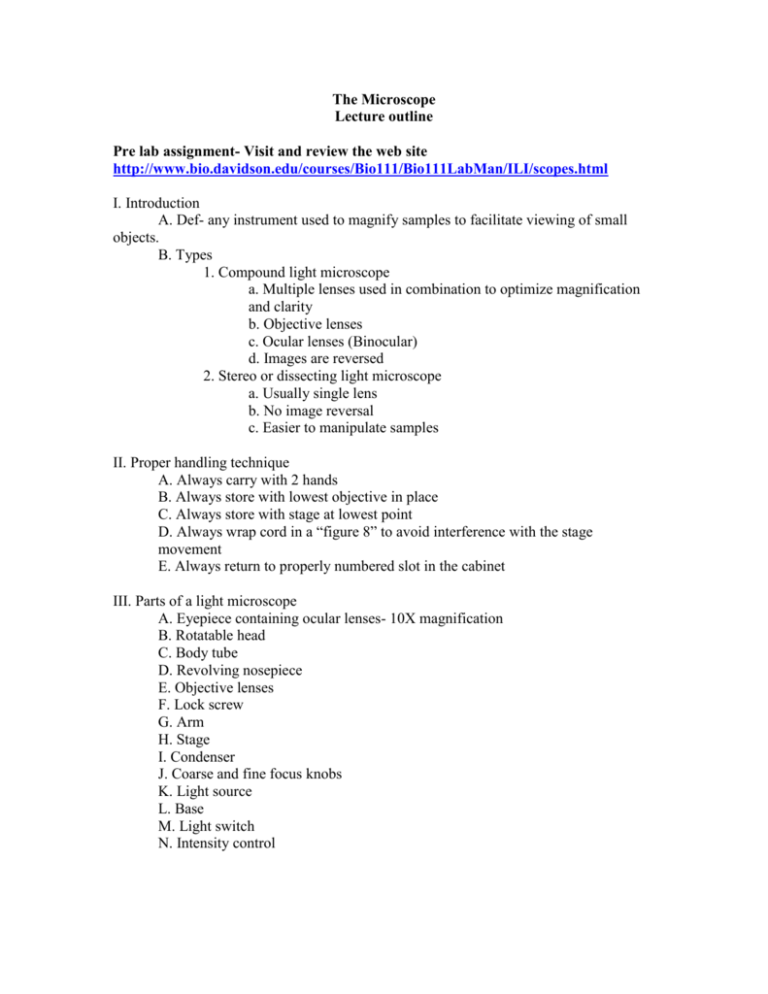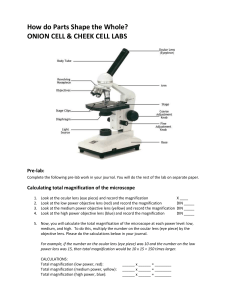The Microscope - SCF Faculty Site Homepage
advertisement

The Microscope Lecture outline Pre lab assignment- Visit and review the web site http://www.bio.davidson.edu/courses/Bio111/Bio111LabMan/ILI/scopes.html I. Introduction A. Def- any instrument used to magnify samples to facilitate viewing of small objects. B. Types 1. Compound light microscope a. Multiple lenses used in combination to optimize magnification and clarity b. Objective lenses c. Ocular lenses (Binocular) d. Images are reversed 2. Stereo or dissecting light microscope a. Usually single lens b. No image reversal c. Easier to manipulate samples II. Proper handling technique A. Always carry with 2 hands B. Always store with lowest objective in place C. Always store with stage at lowest point D. Always wrap cord in a “figure 8” to avoid interference with the stage movement E. Always return to properly numbered slot in the cabinet III. Parts of a light microscope A. Eyepiece containing ocular lenses- 10X magnification B. Rotatable head C. Body tube D. Revolving nosepiece E. Objective lenses F. Lock screw G. Arm H. Stage I. Condenser J. Coarse and fine focus knobs K. Light source L. Base M. Light switch N. Intensity control IV. Procedure for focusing A. Always begin with the stage at the lowest position and the lowest power objective in place B. Place the edge of the cover slip or a sharpie pen marking in the center of the viewing circle C. Using the coarse focus knob, move the stage up until the edge or mark are in focus. D. Turn the fine focus knob until a crisp image is obtained. E. Using the x/y travel knobs, move the slide to position the sample into the viewing area. F. Use the fine focus knob to obtain a crisp image V. Types of light microscopy (Magnification up to 1000X) A. Bright field 1. Most commonly used technique 2. Light passes directly through the sample and into the ocular lens. 3. Samples appear as dark objects in a light background 4. Requires a stained or pigment containing sample B. Dark field microscopy 1. Sample is illuminated by light at an angle with no light passing directly through sample 2. Allows visualization of uncolored and unstained samples 3. Allows visualization of living samples 4. Organisms appear as bright objects in a dark background. 5. Requires a specialized condenser that blocks light from the center of the field. C. Phase contrast microscopy 1. Sample is viewed utilizing a cone of light 2. Visualization is based on differential refractive index of cells and cell components as compared to the surrounding medium. 3. Allows visualization of uncolored and unstained samples 4. Allows visualization of living samples 5. Allows visualization of internal cellular structures and topography of cell surfaces 6. Requires a very specialized condenser VI. Electron microscopy A. Utilizes a beam of electrons as visualization medium. B. Short wavelength of electron beam allows visualization of objects requiring up to 100,000X magnification or more. C. Samples must be fixed and stained with electron impervious metals VII. Experimental procedure A. View each prepared slide under bright field using proper focusing techniques. Increase magnification by rotating the objective lens to next higher power lens and refocus. B. Draw each sample at 40X, 100X and 400X. Do NOT use the 1000X oil immersion lens!!! C. Note the changes in depth of field and field of view for each increase in magnification. D. Make a wet mount of the pond water sample. (Be sure to include the “chunks” from the bottom of the container.) 1. View wet mount under dark field and phase contrast condenser settings and draw 3 organisms viewed. 2. View comparison white fibers under dark field and phase contrast condenser settings and draw each. E. Report 1. Each student must submit a report using the standard format . 2. All drawings should be included on a separate sheet(s) and labeled with sample name and magnification level as total magnification(not the objective magnification!) 3. The report must contain a conclusion section that addresses the use of microscopy in scientific research or clinical use.






